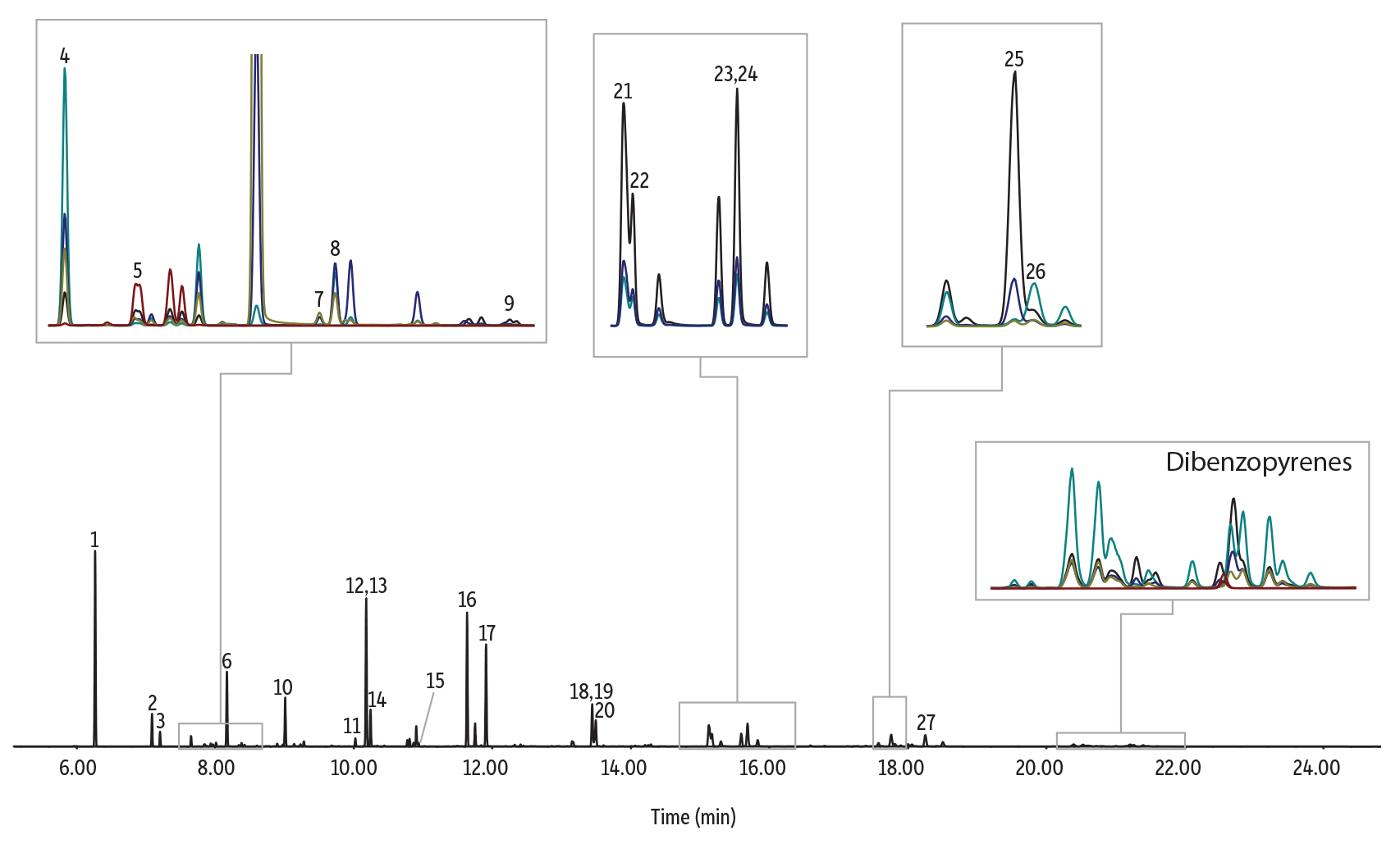Optimized Polycyclic Aromatic Hydrocarbon (PAH) Analysis by GC-MS
Featured Application: Polycyclic Aromatic Hydrocarbons (PAH) on Rxi-SVOCms
| Our Rxi-SVOCms column was named Best New Separations Product of the Year in the SelectScience Scientists' Choice Awards |
- Rxi-SVOCms column provides good separation and response for critical environmental PAH compounds.
- Low column bleed ensures accuracy for late-eluting target analytes.
- Split injection SIM analysis minimizes inlet discrimination.
Polycyclic aromatic hydrocarbons (PAH) are ubiquitous environmental contaminants that form both naturally and due to human activities, primarily through the incomplete combustion of carbon-containing materials. Because some polycyclic aromatic hydrocarbons are carcinogenic, trace-level monitoring of air, water, and soil samples is essential for assessing exposure. PAH analysis by GC-MS using an Rxi-SVOCms column under the optimized conditions shown below provides effective detection of the most relevant compounds.
Using SIM mode and split injection to minimize inlet discrimination for a challenging coal tar sample, good chromatographic performance was seen for a range of PAH compounds. Volatile early eluting compounds exhibit good peak shapes and responses while low column bleed minimizes background interference and improves sensitivity for late eluting compounds. In addition, the efficiency and selectivity of the Rxi-SVOCms column provided good separation of isobaric PAHs, such as benzo[b]fluoranthene and benzo[k]fluoranthene. Good resolution was also obtained for indeno[123-cd]pyrene and dibenz[ah]anthracene (even when there is a disproportionate response), which minimizes the potential for biased results and reporting false positives.
Figure 1: The efficiency and selectivity of Rxi-SVOCms columns ensure excellent separation of critical pairs for PAH analysis by GC-MS.

| Peaks | tR (min) | |
|---|---|---|
| 1. | Naphthalene | 6.27 |
| 2. | 2-Methylnaphthalene | 7.09 |
| 3. | 1-Methylnaphthalene | 7.21 |
| 4. | Biphenyl | 7.66 |
| 5. | 2,6-Dimethylnaphthalene | 7.84 |
| 6. | Acenaphthylene | 8.17 |
| 7. | (IS) Acenaphthene-d10 | 8.35 |
| 8. | Acenaphthene | 8.39 |
| 9. | 2,3,5-Trimethylnaphthalene | 8.86 |
| 10. | Fluorene | 9.02 |
| 11. | Dibenzothiophene | 10.03 |
| 12. | (IS) Phenanthrene-D10 | 10.16 |
| 13. | Phenanthrene | 10.19 |
| Peaks | tR (min) | |
|---|---|---|
| 14. | Anthracene | 10.25 |
| 15. | 1-Methylphenanthrene | 10.95 |
| 16. | Fluoranthene | 11.65 |
| 17. | Pyrene | 11.92 |
| 18. | Benz[a]anthracene | 13.46 |
| 19. | (IS) Chrysene-D12 | 13.47 |
| 20. | Chrysene | 13.51 |
| 21. | Benzo[b]fluoranthene* | 15.14 |
| 22. | Benzo[k]fluoranthene | 15.19 |
| 23. | (SS) Benzo[a]pyrene-d12 | 15.66 |
| 24. | Benzo[a]pyrene | 15.70 |
| 25. | Indeno[1,2,3-cd]pyrene | 17.78 |
| 26. | Dibenz[a,h]anthracene | 17.83 |
| 27. | Benzo[ghi]perylene | 18.27 |
| Column | Rxi-SVOCms, 30 m, 0.25 mm ID, 0.25 µm (cat.# 16623) |
|---|---|
| Standard/Sample | NIST SRM 1597a - complex mixture of polycyclic aromatic hydrocarbons from coal tar |
| Diluent: | Dichloromethane |
| Injection | |
| Inj. Vol.: | 1 µL split (split ratio 20:1) |
| Liner: | Topaz 4.0 mm ID single taper inlet liner with wool (cat.# 23303) |
| Inj. Temp.: | 250 °C |
| Split Vent Flow Rate: | 24 mL/min |
| Oven | |
| Oven Temp.: | 40 °C (hold 0.5 min) to 280 °C at 20 °C/min to 330 °C at 6 °C/min (hold 4 min) |
| Carrier Gas | He, constant flow |
| Flow Rate: | 1.2 mL/min |
| Detector | MS | ||||||||||||||||||||||||||||||||||||||||||||||||||||||||||||
|---|---|---|---|---|---|---|---|---|---|---|---|---|---|---|---|---|---|---|---|---|---|---|---|---|---|---|---|---|---|---|---|---|---|---|---|---|---|---|---|---|---|---|---|---|---|---|---|---|---|---|---|---|---|---|---|---|---|---|---|---|---|
| Mode: | SIM | ||||||||||||||||||||||||||||||||||||||||||||||||||||||||||||
| SIM Program: | |||||||||||||||||||||||||||||||||||||||||||||||||||||||||||||
| |||||||||||||||||||||||||||||||||||||||||||||||||||||||||||||
| Transfer Line Temp.: | 280 °C | ||||||||||||||||||||||||||||||||||||||||||||||||||||||||||||
| Analyzer Type: | Quadrupole | ||||||||||||||||||||||||||||||||||||||||||||||||||||||||||||
| Source Type: | Extractor | ||||||||||||||||||||||||||||||||||||||||||||||||||||||||||||
| Extractor Lens: | 6 mm ID | ||||||||||||||||||||||||||||||||||||||||||||||||||||||||||||
| Source Temp.: | 330 °C | ||||||||||||||||||||||||||||||||||||||||||||||||||||||||||||
| Quad Temp.: | 150 °C | ||||||||||||||||||||||||||||||||||||||||||||||||||||||||||||
| Tune Type: | DFTPP | ||||||||||||||||||||||||||||||||||||||||||||||||||||||||||||
| Ionization Mode: | EI | ||||||||||||||||||||||||||||||||||||||||||||||||||||||||||||
| Instrument | Agilent 7890B GC & 5977A MSD | ||||||||||||||||||||||||||||||||||||||||||||||||||||||||||||
| Sample Preparation | NIST SRM 1597a was diluted 5x in dichloromethane. Isotope-labeled IS/SS are 20 pg on-column. Samples were aliquoted into amber 2 mL, 9 mm short-cap, screw-thread vials (cat.# 21143) containing glass Big Mouth inserts (cat.# 21782) and sealed with 2.0 mL, 9 mm short-cap, screw-vial closures (cat.# 23842). | ||||||||||||||||||||||||||||||||||||||||||||||||||||||||||||
| Notes | The internal standard and surrogate standard mass on column is 20 pg. | ||||||||||||||||||||||||||||||||||||||||||||||||||||||||||||

